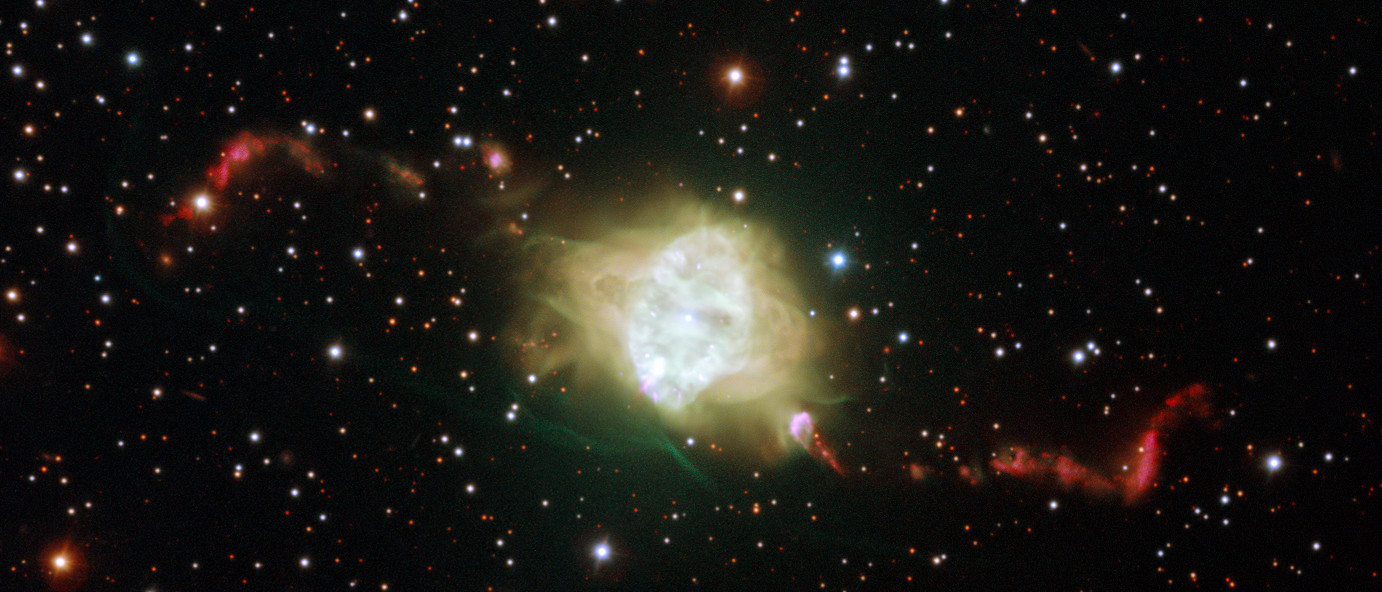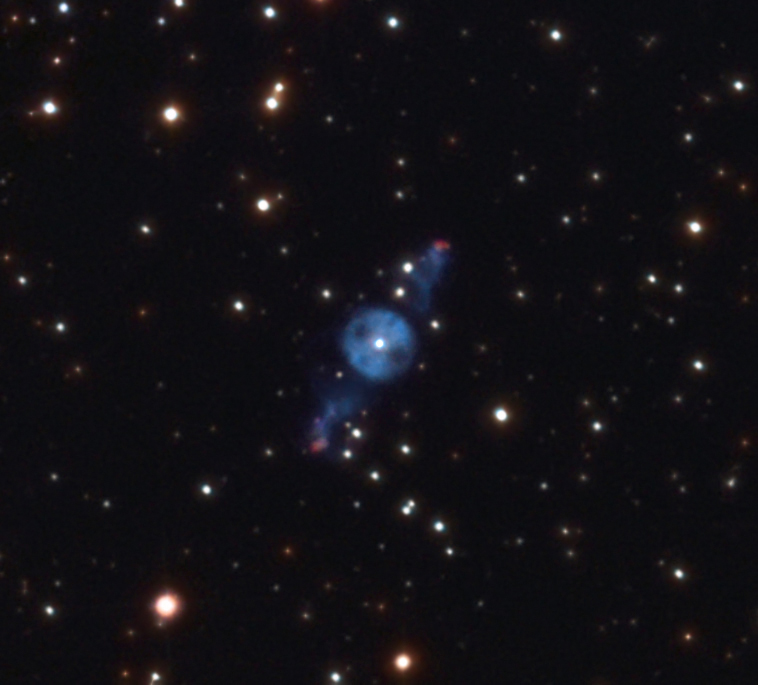Page 1 of 1
APOD: Rings Around the Ring Nebula (2014 Aug 13)
Posted: Wed Aug 13, 2014 4:06 am
by APOD Robot
 Rings Around the Ring Nebula
Explanation:
Rings Around the Ring Nebula
Explanation: It is a familiar sight to sky enthusiasts with even a small telescope. There is much more to the
Ring Nebula (M57), however, than can be seen through a
small telescope. The easily visible
central ring is about one
light-year across, but
this remarkably deep exposure - a collaborative effort combining data from three different large telescopes -
explores the looping filaments of glowing gas extending much farther from the nebula's
central star. This remarkable
composite image includes narrowband hydrogen image, visible light emission, and
infrared light emission. Of course, in this
well-studied example of a
planetary nebula, the glowing material does not come from planets. Instead, the
gaseous shroud represents outer layers expelled from a dying, sun-like star. The
Ring Nebula is about 2,000 light-years away toward the musical
constellation Lyra.
[/b]
Re: APOD: Rings Around the Ring Nebula (2014 Aug 13)
Posted: Wed Aug 13, 2014 4:49 am
by Ann
Congratulations, Rob, that's a great image!
Ann
Re: APOD: Rings Around the Ring Nebula (2014 Aug 13)
Posted: Wed Aug 13, 2014 9:41 am
by MargaritaMc
Just a quick
thank you to the editor for today's links in the Apod text.
These two especially (behind the hyperlinks in "this well-studied example of a planetary nebula" ) I found very interesting and helpful:
http://www.caha.es/the-ring-nebula.html and
http://www.noao.edu/jacoby/
M
Re: APOD: Rings Around the Ring Nebula (2014 Aug 13)
Posted: Wed Aug 13, 2014 3:47 pm
by Psnarf
Dr. Gendler never ceases to amaze me.
Is it serendipity that the axis of this nebula points in our direction, or would the same view be visible, say, from someplace out on the X-axis?. (Z-Axis from Earth to the center, X-axis horizontal, Y-axis vertical)
Re: APOD: Rings Around the Ring Nebula (2014 Aug 13)
Posted: Wed Aug 13, 2014 5:46 pm
by hlwelborn
Holy Toledo !
Re: APOD: Rings Around the Ring Nebula (2014 Aug 13)
Posted: Wed Aug 13, 2014 9:27 pm
by KarelVreeburg
I tried before, but,... This is not a planetary Nebula. Not possible. The material is not expelled from the equator, but is ejected from the poles, south and north, Thus forming a perfect hourglass nebula. If there were planets, they are not involved in this process. I suppose you don’t believe me, but ,… If you look better you will know why, I can explain, if you want. Karel
Re: APOD: Rings Around the Ring Nebula (2014 Aug 13)
Posted: Thu Aug 14, 2014 3:17 am
by geckzilla
KarelVreeburg wrote:I tried before, but,... This is not a planetary Nebula. Not possible. The material is not expelled from the equator, but is ejected from the poles, south and north, Thus forming a perfect hourglass nebula. If there were planets, they are not involved in this process. I suppose you don’t believe me, but ,… If you look better you will know why, I can explain, if you want. Karel
Planets are never involved in the formation of planetary nebulas, just like hourglasses are never involved in hourglass nebulas.
http://en.wikipedia.org/wiki/Planetary_nebula
. . . the term 'planetary nebula' is a misnomer that originated in the 1780s with astronomer William Herschel because when viewed through his telescope, these objects appeared to him to resemble the rounded shapes of planets.
Re: APOD: Rings Around the Ring Nebula (2014 Aug 13)
Posted: Thu Aug 14, 2014 3:26 am
by BDanielMayfield
KarelVreeburg wrote:I tried before, but,... This is not a planetary Nebula. Not possible. The material is not expelled from the equator, but is ejected from the poles, south and north, Thus forming a perfect hourglass nebula. If there were planets, they are not involved in this process. I suppose you don’t believe me, but ,… If you look better you will know why, I can explain, if you want. Karel
This is too a planetary nebula Karel, and yes, planets are not involved in the processes (aging stars shedding outer material) that form them. They're only called "planetary" because they can resemble a planet to a telescopic observer.
(as also explained above by Geck.)
Re: APOD: Rings Around the Ring Nebula (2014 Aug 13)
Posted: Thu Aug 14, 2014 4:09 am
by Boomer12k
One of my favorite objects....and one of my best efforts to photograph.
I was quite stunned when I first saw the pictures of the outer areas of the nebula.
And this is also a GREAT SHOT OF IT! Such detail....
:---[===] *
Re: APOD: Rings Around the Ring Nebula (2014 Aug 13)
Posted: Thu Aug 14, 2014 4:17 am
by Boomer12k
Maybe "Planetary Nebula"...and even "Nebula"...should be re-evaluated, and renamed...."STAR NEBULA"....or "Star Remnant"....as they are not Supernova, or Nova...but are...as pointed out...not Planets...and even "nebula" can be confusing as there are several other types...Dust...Emission...Reflection...etc.... We do say..."Supernova Remnant", not "Supernova Nebula",....so why not..."Stellar Remnant"..?
In recent years...OTHER OBJECTS have been redefined....so why not this too?
Maybe a conference at the next Symposium.....

:---[===] *
Re: APOD: Rings Around the Ring Nebula (2014 Aug 13)
Posted: Thu Aug 14, 2014 7:36 am
by Guest
What we are looking at looks like rings, but we only see it from the top or the bottom. If you would see it from the side you would probably see something like the red square nebula which is an hourglass nebula
http://apod.nasa.gov/apod/ap121216.html
Re: APOD: Rings Around the Ring Nebula (2014 Aug 13)
Posted: Thu Aug 14, 2014 2:44 pm
by geckzilla
Guest wrote:hourglass nebula
Ok, let's explain the "hourglass nebula" as it has been mentioned twice, now. An hourglass nebula is just a way to describe any nebula which is shaped like an hourglass, which may not even refer to a planetary nebula. It is not a classification of nebulas. Many hourglass shaped nebulas are young planetary nebulas in which we observe the early stages of a planetary nebula's development. The hourglass shape is caused by two collimated outflows which are often (but
not always) symmetrical in shape.
You can suppose that the Ring Nebula looks like the Red Rectangle when viewed from another angle but such assumptions should be taken with a grain of salt. It is very hard to measure the distance to individual pieces of the nebula and therefore very difficult to construct a three-dimensional image of the thing. Nonetheless, some clever sleuthing work has been done in an effort to do just this, and it has
not been described as hourglass shaped. Have a look.

- Not an hourglass.
AstroBob explains
Spacetelescope.org article
Actual paper full of science in all of its confounding glory
Re: APOD: Rings Around the Ring Nebula (2014 Aug 13)
Posted: Thu Aug 14, 2014 3:15 pm
by bystander
Re: APOD: Rings Around the Ring Nebula (2014 Aug 13)
Posted: Thu Aug 14, 2014 4:23 pm
by geckzilla
Thanks, I didn't include the second or third because they didn't deal so much with the structure.
Re: APOD: Rings Around the Ring Nebula (2014 Aug 13)
Posted: Thu Aug 14, 2014 4:44 pm
by bystander
Yeah, but they are full of science in all of its confounding glory.
Re: APOD: Rings Around the Ring Nebula (2014 Aug 13)
Posted: Thu Aug 14, 2014 4:45 pm
by geckzilla
Emphasis on the confounding part.
Re: APOD: Rings Around the Ring Nebula (2014 Aug 13)
Posted: Thu Aug 14, 2014 4:56 pm
by starsurfer
This is one of the few planetary nebulae known to have a double halo, one other well known example is NGC 2438. Haloes are actually quite common and represent the AGB mass loss of the progenitor star. I'm currently obsessed with them! Also the one around M57 also contains OIII emission but isn't seen in this image.
Re: APOD: Rings Around the Ring Nebula (2014 Aug 13)
Posted: Thu Aug 14, 2014 7:14 pm
by owlice
geckzilla wrote:Emphasis on the confounding part.
lol!!
Re: APOD: Rings Around the Ring Nebula (2014 Aug 13)
Posted: Thu Aug 14, 2014 7:34 pm
by Karel Vreeburg
It seems nobody is listening, Your problem,.. "Rings" like this are expressions of polar expulsions of matter. I don’t mind if before we were wrong because we did not understand. Now with better 3-D knowledge we should be aware that things we see are not the things that we see. If hourglass is the best word , I don’t know. But polar Precession jets YES. Remnants caused by circular polar Jets. Which to my opinion always result into hourglass Nebula. Even big star galaxies behave like this.
http://apod.nasa.gov/apod/ap121205.html Look, Think Decide. Even in big galaxies there is a precession of polar axes. If there is not such a movement images like this would be impossible. Karel
Re: APOD: Rings Around the Ring Nebula (2014 Aug 13)
Posted: Thu Aug 14, 2014 7:48 pm
by geckzilla
Karel, just because you failed to convince me doesn't mean I didn't listen to you. I think you are wrong and I cited some reasons why. If there is some kind of research with results contrary to the research I noted, you should let us see it. Otherwise I have to assume this is your own home-brew theory.
Re: APOD: Rings Around the Ring Nebula (2014 Aug 13)
Posted: Fri Aug 15, 2014 5:00 pm
by starsurfer
Karel Vreeburg wrote:It seems nobody is listening, Your problem,.. "Rings" like this are expressions of polar expulsions of matter. I don’t mind if before we were wrong because we did not understand. Now with better 3-D knowledge we should be aware that things we see are not the things that we see. If hourglass is the best word , I don’t know. But polar Precession jets YES. Remnants caused by circular polar Jets. Which to my opinion always result into hourglass Nebula. Even big star galaxies behave like this.
http://apod.nasa.gov/apod/ap121205.html Look, Think Decide. Even in big galaxies there is a precession of polar axes. If there is not such a movement images like this would be impossible. Karel
I think you're trying to say something scientifically valid but maybe not expressing yourself in the correct way. However there are a few known examples of planetary nebulae with jets, see below:
Fg 1:
http://www.eso.org/public/images/eso1244a/
Copyright: ESO
ETHOS 1:
http://www.capella-observatory.com/Imag ... ETHOS1.htm
Copyright: Stefan Binnewies and Josef Pöpsel
There are other examples such as Abell 63 and Longmore 16.
Also the so-called "rings" you refer to are the outer halo of the planetary nebula, this is produced before the original star moves onto the planetary nebula phase.
Finally, you are right that our two-dimensional perspective of three-dimensional structures are not the same but astronomers can now do a good job at figuring out the 3D structure of a planetary nebula.
 Rings Around the Ring Nebula
Rings Around the Ring Nebula
